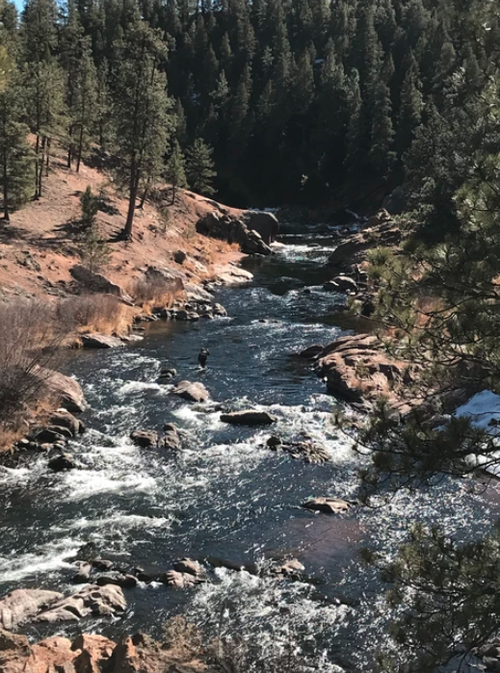Knowing how to read a river is arguably one of the most important aspects of fly fishing and can be the most difficult to learn. You can be fishing a high producing river and have the right flies on your line, but if you aren’t fishing the right sections, your odds of catching fish will diminish. While there’s no substitute for time spent on the river, understanding the different sections of the river and the best time to fish those areas, will help speed up the learning process.

Trout are concerned about one thing, survival, and their survival relies upon their ability to avoid predators, conserve energy and consume food. Based on these three factors, we will discuss the primary sections of a river where trout hold. While these sections may vary depending upon the size of the river, in general, all rivers will consist of three primary sections: riffles, runs and pools. Branching off of those sections, we can look closer at secondary holding areas that will help you further dissect the river.
Primary Sections:
Riffle: A riffle can be categorized as a rocky and shallow section of a river. Riffles form when there is a drop in elevation and are concentrated with small/medium sized rocks. You can identify riffles by looking for significant surface disturbance or “choppy water”. Unlike pools and runs, riffles are a temporary holding position for trout looking to feed or consume more oxygen. Knowing this, there are two scenarios when fishing riffles is ideal. The first scenario is leading up to or during a hatch. Trout will slide into the riffles to consume the bugs that are releasing from the river bottom. Due to the velocity of the water and having less time to identify an artificial fly, trout are not as selective and will feed more aggressively. The second scenario is when water temperatures rise above 50 degrees. When water temperatures rise, the oxygen content decreases. This is most apparent in the slow water. So, in order to consume more oxygen, trout will hold in faster moving sections of the river, such as riffles, where oxygen levels are higher. To keep it simple, afternoons during late spring, summer and early fall, is generally the best time to target riffles.
Run: Runs are formed below a riffle. At this point, the river deepens, the water velocity will decrease and the currents become more consistent. Runs are a primary holding position for trout year-round. In a run, trout have the ability to hold at varying depths of the river to conserve energy and feed. The deeper water columns of a run will offer slower currents, which makes for an ideal resting location. On the other hand, the upper half of the water column is where trout will feed. Bugs that aren’t consumed in the riffles will flow through the run and provide trout with a consistent food source. Frequently adjusting your depth in these sections will help you locate feeding trout.
Pool: Pools are found directly below runs and are the deepest section of the river with the slowest current. While trout hold in pools year-round, they are ideal during sunny conditions and periods with low water temperature. Pools are “home base” during winter and early spring but also offer trout a low stress environment when they need to conserve energy. Slow currents make for easier drifts, but due to the decreased water velocity and food options, trout are more selective and difficult to fool. Slow water means trout have more time to inspect and refuse your flies, making presentation imperative. Absent a hatch, getting your flies deep will be the best way to find fish in a pool.
Secondary Sections:
Tailout: A tailout refers to the bottom section of a pool where the current converges and creates a narrower seam. A shelf is formed before the bottom of the river rises and breaks into a riffle, creating a low velocity pocket for trout to hold. The convergence of multiple currents creates a funnel that consolidates the bugs. This makes tailouts an ideal position for feeding trout to hold during a hatch. A tailout is a great section to focus on when fishing dries and is equally productive when nymphing with emerger patterns.
Banks & Outer Seams: Outer seams are formed when the faster current of a riffle or run meets slow water along a bank. Because the seam separates a faster moving section from a slow section, it offers trout the ability to hold along the slow side of the seam and slide into the faster current to consume food. Banks offer slower currents due to obstructions along the bank breaking up the river current. Considering shallow water exposes trout to aerial predators, banks are risky sections for trout to hold. In general, trout will only hold along the banks during periods with low light, hatch activity and during runoff.
Pockets: Pockets are formed by large rocks, logs or other obstructions that protrude above the surface of the river. The large object displaces the current and creates a slow pocket for trout to hold. An emerging rock will create a seam on both sides of the rock before consolidating into a single seam below the pocket. These seams collect bugs and provide trout easy access to food. Look for trout to hold along the inside seams behind the rock, in the converged seam below the pocket and directly above the rock. Pockets are often overlooked by anglers, but we encourage you to show them some love. Heavy weight and quick casts will be necessary to successfully fish the pockets.
